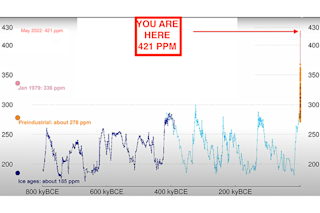Every year at this time, headlines proclaim that carbon dioxide in the atmosphere has climbed to record high levels. But that really shouldn't be all that surprising, given that CO2 has risen to a new high every single year but one since direct measurements began in 1958.
Now, however, an arguably more meaningful milestone has been passed.
The National Oceanic and Atmospheric Administration reports that in May, the concentration of CO2 in the atmosphere peaked at a level 50 percent higher than the pre-industrial average, before we humans began widespread burning of fossil fuels.
NOAA's measurements of atmospheric carbon dioxide at its Mauna Loa observatory in Hawaii averaged 420.99 parts per million during May. There hasn't been that much CO2 in the atmosphere since an episode in the geologic record known as the Pliocene Climate Optimum — which occurred more than 4 million years ago.
At that time, with comparable CO2 levels to today's, research shows that temperatures were about 4 degrees C warmer than in pre-industrial times. That, in turn, meant sea levels were as much as 25 meters higher than today — enough to thoroughly inundate many coastal cities.
Humans have never experienced CO2 levels this high before, according to Pieter Tans, senior scientist with NOAA's Global Monitoring Laboratory. But once again, given how relentless our outpouring of CO2 into the atmosphere has been, this really should come as no surprise. “We have known about this for half a century and have failed to do anything meaningful about it," he's quoted in NOAA's announcement as saying.
"What's it going to take for us to wake up?"
Why Does CO2 Peak Every May?
Carbon dioxide does not rise in a straight line, as seen here:

The seasonal ups and downs of atmospheric carbon dioxide, driven by growth and then decay of plants in the Northern Hemisphere, are small in comparison with the relentlessly rising long-term trend. (Credit: NOAA)
NOAA
Plant growth and then decay is responsible for a seasonal cycle.
Growing vegetation draws CO2 out of the atmosphere during the Northern Hemisphere's spring and summer. In fall and winter, vegetation dies and decays, causing atmospheric CO2 to climb. The greenhouse gas peaks every May, at the end of the Northern Hemisphere cool season. Then, as temperatures warm, plant growth accelerates, drawing CO2 levels down again. (The cycle is dominated by plants in the Northern Hemisphere because there are more of them there due to the larger landmass.)
Over the long-term, atmospheric concentrations of CO2 and other greenhouse gases like methane have risen relentlessly. This has caused huge amounts of heat to build up in the atmosphere, resulting in higher temperatures and a host of climatic impacts — from heat waves, intense droughts and wildfire activity, to extreme precipitation events and flooding.
Last year, this heat build-up neared its own meaningful, if unsurprising, milestone: Greenhouse gas pollution caused by humans trapped 49 percent more heat in the atmosphere in 2021 than it did in 1990, according to NOAA.














